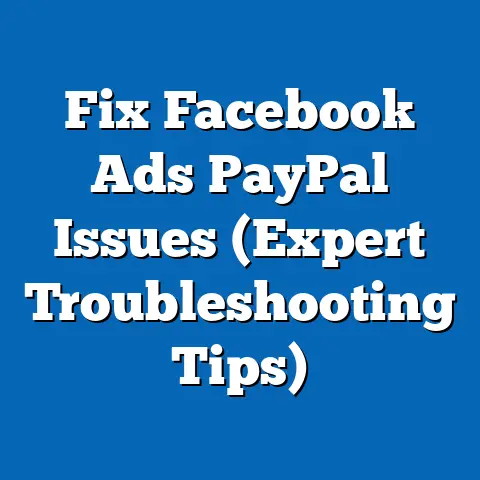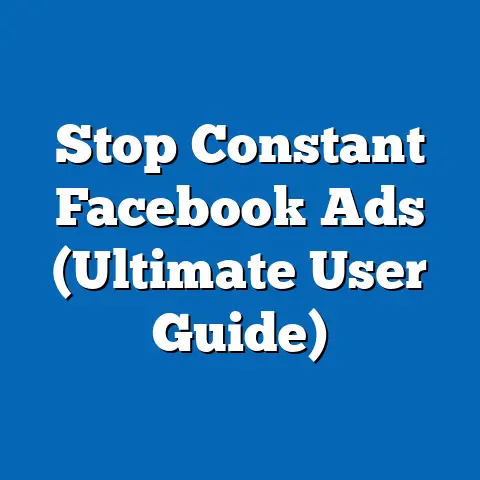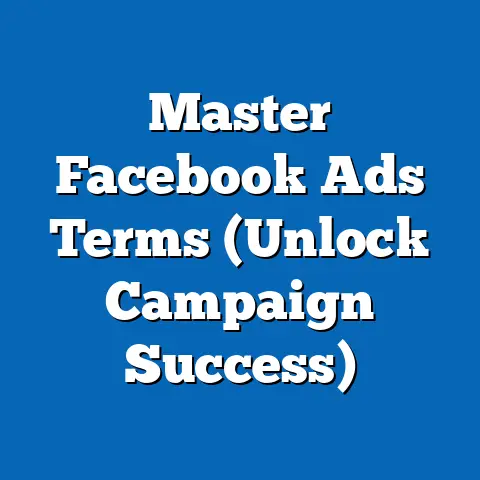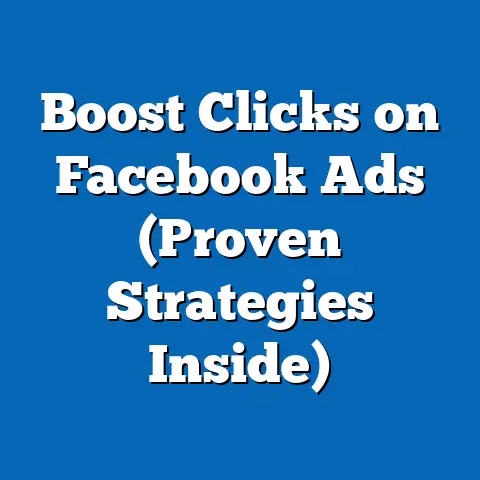Mastering Facebook Ads for Conversions (Proven Strategies)
Facebook advertising has dramatically evolved. I’ve witnessed firsthand how its upgrades have reshaped the digital marketing landscape. The recent changes, particularly in targeting, ad formats, and performance analytics, demand a strategic shift to maximize conversion rates. From new ad placements to enhanced machine learning algorithms, the platform’s dynamic nature requires advertisers to adapt and optimize continuously. In this guide, I’ll share proven strategies to navigate these changes and drive conversions through effective Facebook ad campaigns.
Understanding the Facebook Ads Ecosystem
Before diving into specific tactics, I want to demystify how Facebook Ads actually work. At its core, Facebook advertising is a bidding system. You’re essentially competing with other advertisers to display your ad to a specific audience. The “ad auction” determines which ads get shown based on factors like your bid, ad quality, and estimated action rates.
It’s crucial to understand the concept of “relevance score.” This score reflects how well your ad resonates with your target audience. A higher relevance score can lead to lower costs and better ad placement. Facebook rewards ads that are engaging and relevant, making it essential to focus on creating high-quality content that speaks directly to your audience’s needs and interests.
Now, let’s talk about ad formats. Facebook offers a variety of options, each with its own strengths.
- Image Ads: These are simple and effective for showcasing products or services with visually appealing images.
- Video Ads: Video is incredibly engaging and can be used to tell stories, demonstrate products, or share testimonials. I’ve found video ads particularly powerful for capturing attention in the busy Facebook feed.
- Carousel Ads: These allow you to display multiple images or videos in a single ad, making them perfect for showcasing a range of products or highlighting different features of a service.
- Collection Ads: Designed for e-commerce, these ads feature a primary video or image with a selection of products below, allowing users to browse and purchase directly from the ad.
Choosing the right ad format depends on your goals and target audience. For instance, if you’re launching a new product, a video ad demonstrating its features might be most effective. If you’re running an e-commerce store, collection ads can drive direct sales.
The foundation of any successful Facebook ad campaign is a deep understanding of your target audience. Facebook’s Audience Insights tool is invaluable for this. It provides data on demographics, interests, behaviors, and more, helping you create highly targeted ad campaigns. I’ve personally used Audience Insights to uncover hidden interests and refine my targeting, resulting in significantly improved ad performance.
Takeaway: Grasp the fundamentals of Facebook’s ad auction, relevance scores, and ad formats. Use Audience Insights to know your target audience intimately.
Crafting Compelling Ad Copy
Ad copy is the voice of your brand on Facebook. It’s what grabs attention, sparks interest, and ultimately drives conversions. Effective ad copy is more than just words; it’s a carefully crafted message that resonates with your audience on an emotional level.
Let’s break down the key elements:
- Attention-Grabbing Headlines: Your headline is the first thing people see. It needs to be concise, compelling, and relevant to your audience’s needs. Use strong verbs, ask questions, or create a sense of urgency to capture attention.
- Persuasive Body Text: This is where you expand on your headline and explain the benefits of your product or service. Focus on how you can solve your audience’s problems or fulfill their desires. Use clear, concise language and avoid jargon.
- Clear Calls-to-Action (CTAs): Your CTA tells people what you want them to do next. Use strong, action-oriented verbs like “Shop Now,” “Learn More,” “Sign Up,” or “Get Started.” Make your CTA prominent and easy to click.
I’ve seen firsthand how powerful storytelling can be in ad copy. People connect with stories on an emotional level, making them more likely to engage with your ad. Consider sharing a customer testimonial, highlighting a personal experience, or creating a narrative that resonates with your audience’s values.
For example, instead of saying “Our product is the best,” try telling a story about how your product helped a customer overcome a challenge. This approach is more engaging and builds trust.
It’s also crucial to align your ad copy with your audience’s emotions and pain points. What are their biggest frustrations? What are their aspirations? Use your ad copy to address these concerns and position your product or service as the solution.
Here’s an example of successful ad copy that led to high conversion rates:
Headline: Tired of Wasting Time on Social Media?
Body Text: Discover the secret to building a thriving online community in just 15 minutes a day. Our proven system will help you attract your ideal customers, boost engagement, and drive sales.
CTA: Get Started Now
This ad copy addresses a common pain point (wasting time on social media), offers a clear benefit (building a thriving online community), and includes a strong CTA.
Takeaway: Craft ad copy that grabs attention, addresses pain points, and uses storytelling to connect with your audience on an emotional level. Always include a clear and compelling CTA.
Designing Eye-Catching Visuals
In the crowded landscape of social media, visuals are your secret weapon. They have the power to stop people in their tracks, capture their attention, and convey your message in a split second.
A well-designed visual can dramatically impact user engagement and conversions. Think of it as the first impression your ad makes. If it’s visually appealing and relevant, people are more likely to click and learn more.
Here are some best practices for creating visuals that stand out:
- Use High-Quality Images and Videos: Avoid blurry or pixelated images. Invest in professional photography or use high-quality stock photos. For videos, ensure they are well-lit and have clear audio.
- Choose the Right Colors: Colors evoke emotions and can influence people’s perceptions. Use colors that align with your brand and the message you’re trying to convey. For example, blue often conveys trust and stability, while red evokes excitement and energy.
- Incorporate Branding Elements: Use your logo, brand colors, and fonts consistently to reinforce your brand identity.
- Keep it Simple: Avoid clutter and overwhelming designs. Focus on a clear message and a visually appealing layout.
I’ve found that user-generated content (UGC) can be incredibly effective in Facebook ads. UGC is content created by your customers, such as photos, videos, or reviews. It’s authentic, relatable, and builds trust.
Tools like Canva, Adobe Spark, and Facebook’s Creative Hub can help you create stunning visuals without being a professional designer. These tools offer templates, design elements, and easy-to-use interfaces that make it simple to create eye-catching ads.
Takeaway: Invest in high-quality visuals that are relevant, visually appealing, and aligned with your brand. Consider using user-generated content and leverage design tools to create professional-looking ads.
Leveraging Targeting Options
Facebook’s targeting capabilities are a game-changer for advertisers. They allow you to reach specific groups of people based on a wide range of criteria, ensuring that your ads are seen by those most likely to be interested in your products or services.
Here are the key targeting options:
- Demographic Targeting: This allows you to target people based on factors like age, gender, location, education, and job title.
- Interest-Based Targeting: This targets people based on their interests, hobbies, and the pages they’ve liked on Facebook.
- Behavioral Targeting: This targets people based on their online behavior, such as purchase history, device usage, and travel habits.
But the real magic happens when you start creating custom audiences and lookalike audiences.
- Custom Audiences: These are audiences you create based on your own data, such as email lists, website visitors, or app users. You can upload your customer list to Facebook and target those people directly with your ads.
- Lookalike Audiences: These are audiences that Facebook creates based on your custom audiences. Facebook analyzes the characteristics of your custom audience and finds other people who are similar. This is a powerful way to expand your reach and find new potential customers.
Retargeting is another essential strategy for driving conversions. Retargeting involves showing ads to people who have previously interacted with your brand, such as visiting your website, watching a video, or adding items to their cart. These people are already familiar with your brand and are more likely to convert.
Takeaway: Master Facebook’s targeting options to reach the right people with the right message. Use custom audiences and lookalike audiences to expand your reach and target potential customers. Implement retargeting strategies to convert users who have already interacted with your brand.
Optimizing Ad Campaigns for Conversions
Optimization is the ongoing process of refining your ad campaigns to improve performance and drive conversions. It’s not a one-time task; it’s a continuous cycle of testing, analyzing, and adjusting.
A/B testing, also known as split testing, is a crucial part of optimization. It involves creating multiple versions of your ad with slight variations and testing them against each other to see which performs best. You can test different headlines, images, ad copy, CTAs, and targeting options.
By analyzing key performance metrics, you can identify areas for improvement and make data-driven decisions.
Here are some of the most important metrics to track:
- Click-Through Rate (CTR): This measures the percentage of people who click on your ad after seeing it. A high CTR indicates that your ad is relevant and engaging.
- Conversion Rate: This measures the percentage of people who take the desired action after clicking on your ad, such as making a purchase, filling out a form, or signing up for a newsletter.
- Return on Ad Spend (ROAS): This measures the revenue you generate for every dollar you spend on advertising. A high ROAS indicates that your ad campaigns are profitable.
I always recommend setting up conversion tracking to accurately measure your results. This involves placing a piece of code on your website that tracks when someone completes a desired action after clicking on your ad.
Based on the data you collect, you can refine your campaigns by:
- Adjusting Your Targeting: If your ads aren’t reaching the right people, you may need to refine your targeting options.
- Improving Your Ad Copy and Visuals: If your ads aren’t engaging, you may need to experiment with different headlines, images, and ad copy.
- Optimizing Your Bids: If your ads aren’t getting enough impressions, you may need to increase your bids.
Takeaway: Continuously optimize your ad campaigns by A/B testing variations, analyzing performance metrics, and refining your targeting, ad copy, and bids.
Utilizing Facebook Pixel for Tracking
The Facebook Pixel is a small piece of code that you place on your website to track user behavior. It’s an essential tool for optimizing your Facebook ad campaigns and driving conversions.
Here’s how it works:
When someone clicks on your Facebook ad and visits your website, the Facebook Pixel tracks their actions, such as viewing pages, adding items to their cart, and making purchases. This data is then sent back to Facebook, allowing you to:
- Track Conversions: See which of your ads are driving the most conversions.
- Retarget Website Visitors: Show ads to people who have visited your website but haven’t yet converted.
- Create Lookalike Audiences: Find new potential customers who are similar to your existing customers.
- Optimize Your Ads: Improve your ad targeting and bidding strategies based on real-time data.
Setting up the Facebook Pixel is relatively straightforward. You can find the code in your Facebook Ads Manager and then add it to the header of your website. There are also plugins available for popular content management systems like WordPress that make the process even easier.
To maximize the effectiveness of the Facebook Pixel, be sure to set up conversion events. These are specific actions that you want to track, such as purchases, form submissions, or sign-ups. By tracking these events, you can gain a deeper understanding of how your ads are driving results.
Takeaway: Install the Facebook Pixel on your website to track user behavior and optimize your ad campaigns. Set up conversion events to accurately measure your results.
Conclusion
Mastering Facebook Ads for conversions requires a strategic approach that encompasses understanding the platform’s ecosystem, crafting compelling content, leveraging targeting options, continuously optimizing campaigns, and utilizing the Facebook Pixel for tracking. By adapting to the latest upgrades, advertisers can achieve significant results and stay ahead of the competition. Remember to stay informed about future updates and trends in Facebook advertising to maintain a competitive edge and drive sustainable growth for your business.





